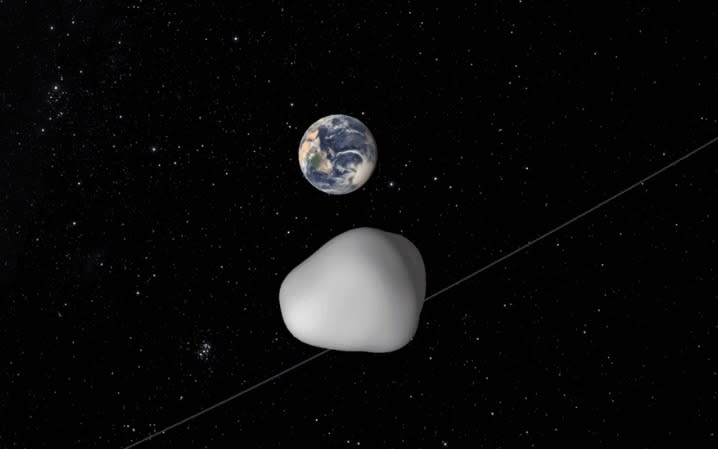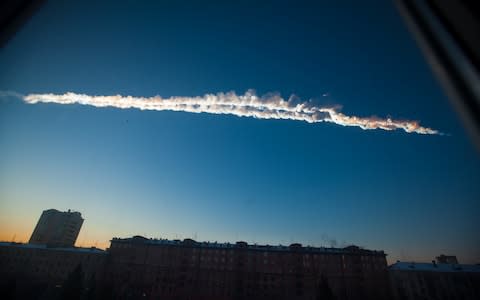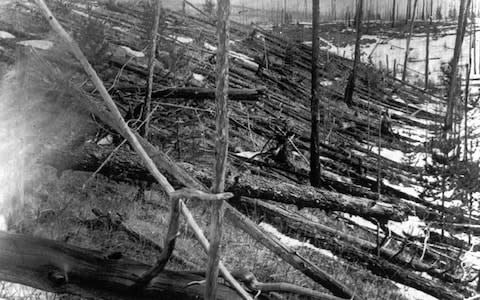Asteroid 2012 TC4 flew ‘damn close’ to Earth today - but how prepared are we for a strike?

An asteroid the size of a house was being watched carefully this morning by astrophysicists as it hurtled “damn close” to Earth.
The large space rock, named 2012 TC4, was first spotted five years ago by the Pan-STARRS telescope at the Haleakala Observatory, in Hawaii, before disappearing as it orbits the sun. It then reemerged in July on a trajectory well inside our lunar orbit.
Scientists said the asteroid swung by Earth about 6:42am BST, passing over Antarctica, and posed no threat.
However it did present space agencies with a rare opportunity to test the planet’s space defences and wargame what they would do if a larger, more threatening asteroid was detected heading straight for Earth.
How close did TC4 come to Earth?
TC4 is between 50 to 100ft in diameter and travelling through space at roughly 16,000 mph - 4.5 miles a second. It is past within 27,000 miles of Antarctica.
This may sound like a long way away, yet it’s a short distance in planetary terms and around one eighth of the distance between the Earth and the Moon. It is also just above the distance our satellites orbit.
Earth's close encounter with asteroid TC4
Rolf Densing, who heads the European Space Operations Centre in Darmstadt, Germany said: “It's damn close. The farthest satellites are 36,000 kilometres [22,000 miles] out, so this is indeed a close miss.
“TC4 poses absolutely no threat to the planet, but it does afford a chance to test our asteroid tracking and space defence capabilities”.
Has Earth been struck before?
Earth has been struck by asteroids and meteors repeatedly over its 4.5 billion year lifespan, however the chances of a serious incident happening again in our lifetime are remote.
The most famous event was the sixty mile-wide asteroid that struck the coast of Mexico around 65 million years ago and is thought to have lead to the extinction of the dinosaurs. But there have been more recent, less dramatic examples.
Meteor over Chelyabinsk Russia in 2013
The closest event in living memory happened when a meteor came crashing through the atmosphere in the skies above Chelyabinsk, in central Russia. As opposed to an asteroid, which is a solid chunk of rock, meteors are small clusters of space debris that burn up and turn into a fiery streak when they hit the atmosphere.

According to the Russian Academy of Sciences, the Chelyabinsk meteor was around ten tons and disintegrated before it hit the ground. Around 1,000 people were injured by flying debris as the shock wave from the explosion swept across the Russian city, shattering windows and leaving a trail of damage.
The explosion was estimated to have had a force greater than 30 Hiroshima nuclear bombs, according to Nasa scientists, and the shock wave was so powerful it travelled twice around the world.
The 1908 Tunguska event
The largest recorded asteroid incident is the 1908 Tunguska event in Russia. Eyewitness reports from the time are sparse as the event was not properly investigated until 19 years after it happened. Reports from the time say a fireball believed to be between 160ft and 330ft wide hit an area of remote Siberian forest near the Podkamennaya Tunguska river.

The fireball incinerated around 1,200 square miles of forest, destroying 80 million trees. Residents in the nearest town, 35 miles away, reportedly felt heat from the blast as the ground shook and windows shattered. No official human casualties were reported, although one local deer herder was said to have been killed after being thrown into a tree by the blast. The Tunguska event is estimated to have had 85 times more energy than the Hiroshima atomic bomb.
According to the European Space Agency (ESA) an asteroid or meteor the size of Chelyabinsk hits the Earth on average every 10 to 100 years whereas an object the size of the Tunguska event strikes roughly every hundred to one thousand years.
Did TC4 pose a threat?
Even though TC4’s orbit has been described as ‘damn close’, astrophysicists can now predict asteroids' path to a margin of around 10 miles and were confident TC4 would not come near the Earth’s atmosphere. Even if it were to hit Earth, scientists say it would have an impact similar to that of the Chelyabinsk meteor.
Asteroid TC4 changing orbit around the sun
Detlef Koschny, Near-Earth Object segment manager at the ESA, based in the Netherlands, said: “It's [TC4] smaller [than Tunguska], only about 10-20 metres - [we] just got some radar observations [Monday] night. So it's more like Chelyabinsk in 2013. A shock wave possibly shattering windows; possibly a few meteorites falling down.”
Space defences - how prepared are we?
TC4 does afford space agencies across the globe an opportunity to wargame the planet's space defences for a scenario where Earth was in the path of a more dangerous asteroid. If an asteroid the size of TC4 or slightly bigger was on course to hit a populated area, agencies such as the ESA and NASA would look to warn people and work with relevant governments to potentially start an evacuation.
However if the agencies detected an object over 130ft approaching they would need to start thinking about deflecting the asteroid from Earth's path.
To do this space agencies would fire a satellite into the asteroid in an attempt to shift its trajectory, in what is known as a "kinetic impactor" method. The asteroid would need to be hit when it was at least two years away to give it time alter its trajectory and clear Earth.
Asteroid impact damage
Mr Koschny said: “Yes we have the capability of hitting an asteroid or comet with a satellite. NASA have done that in 2004 with the 'Deep Impact' mission. The difficult thing is the aiming, the Deep Impact target was a comparably large object (a few km). But industry assures us that they could do the same for an object of 100 to 200 metres.”
He added that TC4’s trajectory was only spotted in July due to its relatively small size, but that agencies would more than likely see an asteroid large enough to pose a serious threat to Earth in time to fire a deflector satellite at it.
Was TC4 visible in the UK?
Unfortunately due to its path 2012TC4 was not be visible to stargazers in the UK. The best place to view its passing was Australia, and even then it was only visible via telescope.

